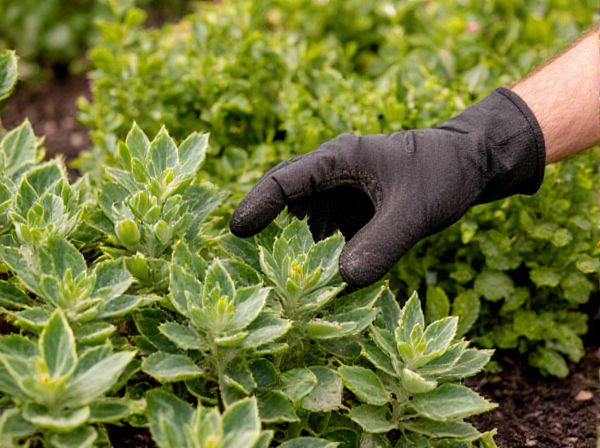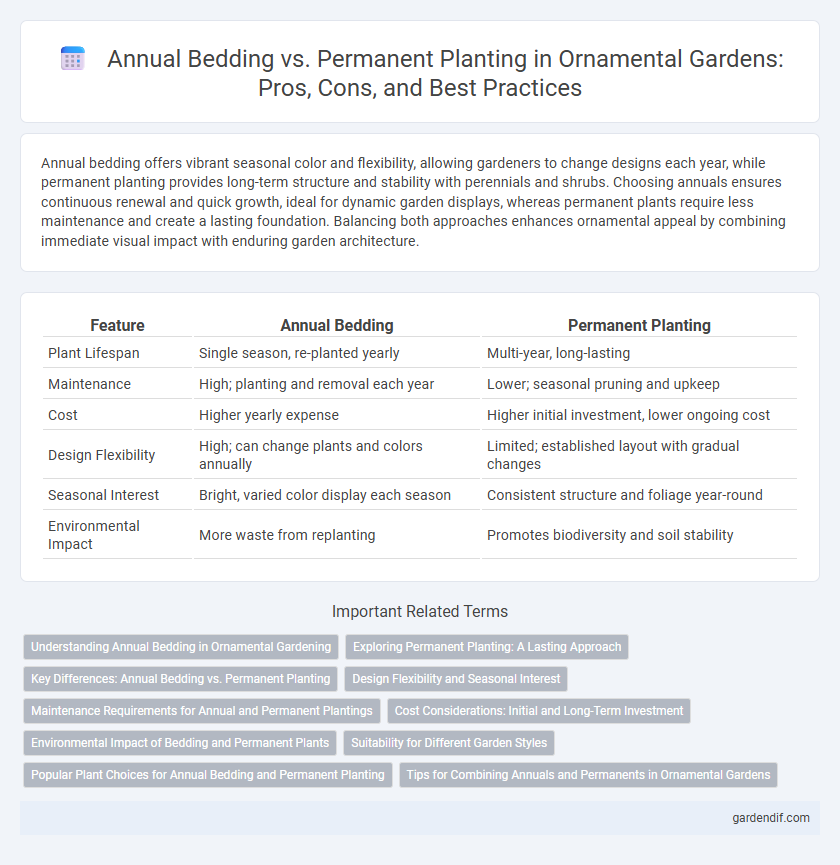
annual bedding vs permanent planting Illustration
Annual bedding offers vibrant seasonal color and flexibility, allowing gardeners to change designs each year, while permanent planting provides long-term structure and stability with perennials and shrubs. Choosing annuals ensures continuous renewal and quick growth, ideal for dynamic garden displays, whereas permanent plants require less maintenance and create a lasting foundation. Balancing both approaches enhances ornamental appeal by combining immediate visual impact with enduring garden architecture.
Table of Comparison
| Feature | Annual Bedding | Permanent Planting |
|---|---|---|
| Plant Lifespan | Single season, re-planted yearly | Multi-year, long-lasting |
| Maintenance | High; planting and removal each year | Lower; seasonal pruning and upkeep |
| Cost | Higher yearly expense | Higher initial investment, lower ongoing cost |
| Design Flexibility | High; can change plants and colors annually | Limited; established layout with gradual changes |
| Seasonal Interest | Bright, varied color display each season | Consistent structure and foliage year-round |
| Environmental Impact | More waste from replanting | Promotes biodiversity and soil stability |
Understanding Annual Bedding in Ornamental Gardening
Annual bedding in ornamental gardening involves planting seasonal flowers that complete their life cycle within one growing season, offering vibrant and diverse color displays. This method allows gardeners to frequently change designs and flower varieties, enhancing garden aesthetics year after year. Understanding the benefits of annual bedding helps optimize garden appeal through strategic selection and timed planting, contrasting with the long-term investment of permanent planting.
Exploring Permanent Planting: A Lasting Approach
Permanent planting offers a sustainable alternative to annual bedding by providing year-round structure and reducing the need for frequent replanting. Incorporating hardy perennials such as lavender, hostas, and ornamental grasses enhances garden resilience and supports local ecosystems through continuous habitat provision. This lasting approach not only lowers maintenance costs but also creates a dynamic, evolving landscape that adapts with seasonal changes.
Key Differences: Annual Bedding vs. Permanent Planting
Annual bedding plants complete their life cycle in one growing season, offering vibrant and seasonal color with quick growth but requiring replanting each year. Permanent planting involves perennial plants or shrubs that establish deep root systems, providing long-term structure, low maintenance, and year-round landscape stability. Annual bedding suits dynamic design changes and seasonal displays, while permanent planting enhances garden permanence and ecological balance.
Design Flexibility and Seasonal Interest
Annual bedding offers unparalleled design flexibility with the ability to change plant varieties and colors each season, allowing for dynamic garden aesthetics tailored to current trends or personal preferences. In contrast, permanent planting provides consistent seasonal interest through established perennials and shrubs that evolve naturally over time, creating a stable and mature landscape foundation. Combining both approaches maximizes year-round visual appeal by blending the predictable structure of permanent plants with the vibrant, ever-changing display of annuals.
Maintenance Requirements for Annual and Permanent Plantings
Annual bedding plants require frequent maintenance including regular watering, deadheading, and replanting each season to sustain vibrant displays. Permanent plantings demand less daily attention but involve periodic pruning, mulching, and soil conditioning to ensure long-term health. Both types benefit from pest management, yet annuals typically need more intensive care due to their shorter lifecycle and higher sensitivity.
Cost Considerations: Initial and Long-Term Investment
Annual bedding plants typically require lower initial investment but incur higher long-term costs due to yearly purchase, planting, and replacement. Permanent plantings demand a greater upfront expense for roots and soil preparation, yet offer cost-effectiveness over time by eliminating seasonal replanting. Evaluating budget constraints with maintenance schedules is crucial for optimizing expenditures in ornamental landscaping projects.
Environmental Impact of Bedding and Permanent Plants
Annual bedding plants require frequent replacement, leading to increased resource consumption and higher waste generation compared to permanent plantings. Permanent plants enhance soil health, support biodiversity, and reduce carbon footprint by providing long-term ecological benefits. Choosing permanent plantings can significantly minimize environmental impact through reduced water usage, less chemical input, and sustained habitat creation.
Suitability for Different Garden Styles
Annual bedding plants offer vibrant seasonal color and are ideal for formal gardens, container displays, and themed seasonal beds where frequent design changes are desired. Permanent planting with perennials and shrubs suits naturalistic, cottage, and woodland garden styles by providing year-round structure and sustainability. Choosing between annuals and permanent plants depends on the garden's aesthetic goals, maintenance preferences, and desired visual impact.
Popular Plant Choices for Annual Bedding and Permanent Planting
Popular plant choices for annual bedding include vibrant petunias, marigolds, and impatiens, known for their quick bloom cycles and colorful displays that transform garden beds each season. Permanent planting often features hardy species such as hostas, daylilies, and boxwood shrubs, prized for their resilience and long-term structural contribution to garden design. Selecting the right combination of annuals and perennials enhances seasonal interest and ensures sustained aesthetic appeal in ornamental landscapes.
Tips for Combining Annuals and Permanents in Ornamental Gardens
Mixing annual bedding plants with permanent perennials enhances garden vibrancy by providing continuous color throughout the seasons. Choose perennials with varying bloom times and pair them with annuals that fill gaps to maintain visual interest year-round. Ensure soil consistency and watering needs align to support healthy growth for both plant types in ornamental landscapes.
annual bedding vs permanent planting Infographic

 gardendif.com
gardendif.com